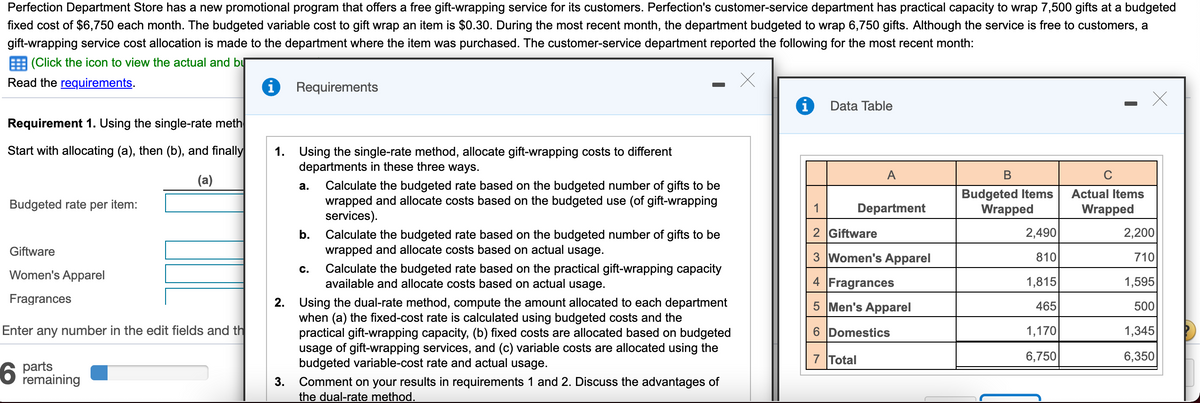Perfection Department Store has a new promotional program that offers a free gift-wrapping service for its customers. Perfection's customer-service department has practical capacity to wrap 7,500 gifts at a budgeted fixed cost of $6,750 each month. The budgeted variable cost to gift wrap an item is $0.30. During the most recent month, the department budgeted to wrap 6,750 gifts. Although the service is free to customers, a gift-wrapping service cost allocation is made to the department where the item was purchased. The customer-service department reported the following for the most recent month: E (Click the icon to view the actual and b Read the requirements. Requirements Data Table %3 Requirement 1. Using the single-rate meth Start with allocating (a), then (b), and finally 1. Using the single-rate method, allocate gift-wrapping costs to different departments in these three ways. A B (a) Calculate the budgeted rate based on the budgeted number of gifts to be wrapped and allocate costs based on the budgeted use (of gift-wrapping services). b. Calculate the budgeted rate based on the budgeted number of gifts to be wrapped and allocate costs based on actual usage. c. Calculate the budgeted rate based on the practical gift-wrapping capacity available and allocate costs based on actual usage. a. Budgeted Items Actual Items Wrapped Budgeted rate per item: Department Wrapped 2 Giftware 2,490 2,200 Giftware 3 Women's Apparel 810 710 Women's Apparel 4 Fragrances 1,815 1,595 500 Fragrances 2. Using the dual-rate method, compute the amount allocated to each department when (a) the fixed-cost rate is calculated using budgeted costs and the practical gift-wrapping capacity, (b) fixed costs are allocated based on budgeted usage of gift-wrapping services, and (c) variable costs are allocated using the budgeted variable-cost rate and actual usage. 5 Men's Apparel 465 Enter any number in the edit fields and th 6 Domestics 1,170 1,345 7 Total 6,750 6,350 parts remaining 3. Comment on your results in requirements 1 and 2. Discuss the advantages of the dual-rate method.
Perfection Department Store has a new promotional program that offers a free gift-wrapping service for its customers. Perfection's customer-service department has practical capacity to wrap 7,500 gifts at a budgeted fixed cost of $6,750 each month. The budgeted variable cost to gift wrap an item is $0.30. During the most recent month, the department budgeted to wrap 6,750 gifts. Although the service is free to customers, a gift-wrapping service cost allocation is made to the department where the item was purchased. The customer-service department reported the following for the most recent month: E (Click the icon to view the actual and b Read the requirements. Requirements Data Table %3 Requirement 1. Using the single-rate meth Start with allocating (a), then (b), and finally 1. Using the single-rate method, allocate gift-wrapping costs to different departments in these three ways. A B (a) Calculate the budgeted rate based on the budgeted number of gifts to be wrapped and allocate costs based on the budgeted use (of gift-wrapping services). b. Calculate the budgeted rate based on the budgeted number of gifts to be wrapped and allocate costs based on actual usage. c. Calculate the budgeted rate based on the practical gift-wrapping capacity available and allocate costs based on actual usage. a. Budgeted Items Actual Items Wrapped Budgeted rate per item: Department Wrapped 2 Giftware 2,490 2,200 Giftware 3 Women's Apparel 810 710 Women's Apparel 4 Fragrances 1,815 1,595 500 Fragrances 2. Using the dual-rate method, compute the amount allocated to each department when (a) the fixed-cost rate is calculated using budgeted costs and the practical gift-wrapping capacity, (b) fixed costs are allocated based on budgeted usage of gift-wrapping services, and (c) variable costs are allocated using the budgeted variable-cost rate and actual usage. 5 Men's Apparel 465 Enter any number in the edit fields and th 6 Domestics 1,170 1,345 7 Total 6,750 6,350 parts remaining 3. Comment on your results in requirements 1 and 2. Discuss the advantages of the dual-rate method.
Cornerstones of Cost Management (Cornerstones Series)
4th Edition
ISBN:9781305970663
Author:Don R. Hansen, Maryanne M. Mowen
Publisher:Don R. Hansen, Maryanne M. Mowen
Chapter8: Budgeting For Planning And Control
Section: Chapter Questions
Problem 6CE: Play-Disc makes Frisbee-type plastic discs. Each 12-inch diameter plastic disc has the following...
Related questions
Question
can you help me
C.5Q2

Transcribed Image Text:Perfection Department Store has a new promotional program that offers a free gift-wrapping service for its customers. Perfection's customer-service department has practical capacity to wrap 7,500 gifts at a budgeted
fixed cost of $6,750 each month. The budgeted variable cost to gift wrap an item is $0.30. During the most recent month, the department budgeted to wrap 6,750 gifts. Although the service is free to customers, a
gift-wrapping service cost allocation is made to the department where the item was purchased. The customer-service department reported the following for the most recent month:
E (Click the icon to view the actual and by
Read the requirements.
Requirements
Data Table
Requirement 1. Using the single-rate meth
Start with allocating (a), then (b), and finally
1. Using the single-rate method, allocate gift-wrapping costs to different
departments in these three ways.
A
В
C
(a)
Calculate the budgeted rate based on the budgeted number of gifts to be
wrapped and allocate costs based on the budgeted use (of gift-wrapping
services).
а.
Budgeted Items
Wrapped
Actual Items
Budgeted rate per item:
1
Department
Wrapped
b.
2 Giftware
2,490
2,200
Calculate the budgeted rate based on the budgeted number of gifts to be
wrapped and allocate costs based on actual usage.
Giftware
3 Women's Apparel
810
710
Calculate the budgeted rate based on the practical gift-wrapping capacity
available and allocate costs based on actual usage.
с.
Women's Apparel
4 Fragrances
1,815
1,595
Fragrances
2. Using the dual-rate method, compute the amount allocated to each department
when (a) the fixed-cost rate is calculated using budgeted costs and the
practical gift-wrapping capacity, (b) fixed costs are allocated based on budgeted
usage of gift-wrapping services, and (c) variable costs are allocated using the
budgeted variable-cost rate and actual usage.
5 Men's Apparel
465
500
Enter any number in the edit fields and th
6 Domestics
1,170
1,345
7 Total
6,750
6,350
parts
remaining
Comment on your results in requirements 1 and 2. Discuss the advantages of
the dual-rate method.
3.
Expert Solution
This question has been solved!
Explore an expertly crafted, step-by-step solution for a thorough understanding of key concepts.
This is a popular solution!
Trending now
This is a popular solution!
Step by step
Solved in 3 steps with 1 images

Knowledge Booster
Learn more about
Need a deep-dive on the concept behind this application? Look no further. Learn more about this topic, accounting and related others by exploring similar questions and additional content below.Recommended textbooks for you

Cornerstones of Cost Management (Cornerstones Ser…
Accounting
ISBN:
9781305970663
Author:
Don R. Hansen, Maryanne M. Mowen
Publisher:
Cengage Learning

Principles of Accounting Volume 2
Accounting
ISBN:
9781947172609
Author:
OpenStax
Publisher:
OpenStax College

Managerial Accounting
Accounting
ISBN:
9781337912020
Author:
Carl Warren, Ph.d. Cma William B. Tayler
Publisher:
South-Western College Pub

Cornerstones of Cost Management (Cornerstones Ser…
Accounting
ISBN:
9781305970663
Author:
Don R. Hansen, Maryanne M. Mowen
Publisher:
Cengage Learning

Principles of Accounting Volume 2
Accounting
ISBN:
9781947172609
Author:
OpenStax
Publisher:
OpenStax College

Managerial Accounting
Accounting
ISBN:
9781337912020
Author:
Carl Warren, Ph.d. Cma William B. Tayler
Publisher:
South-Western College Pub

Essentials Of Business Analytics
Statistics
ISBN:
9781285187273
Author:
Camm, Jeff.
Publisher:
Cengage Learning,

Managerial Accounting: The Cornerstone of Busines…
Accounting
ISBN:
9781337115773
Author:
Maryanne M. Mowen, Don R. Hansen, Dan L. Heitger
Publisher:
Cengage Learning

Essentials of Business Analytics (MindTap Course …
Statistics
ISBN:
9781305627734
Author:
Jeffrey D. Camm, James J. Cochran, Michael J. Fry, Jeffrey W. Ohlmann, David R. Anderson
Publisher:
Cengage Learning